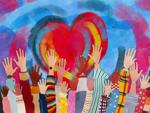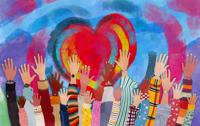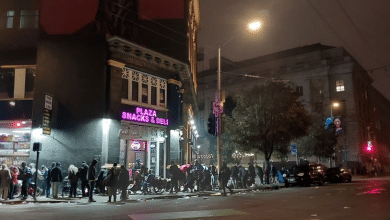Companies guess on magic, lights to lure SF staff downtown | Enterprise
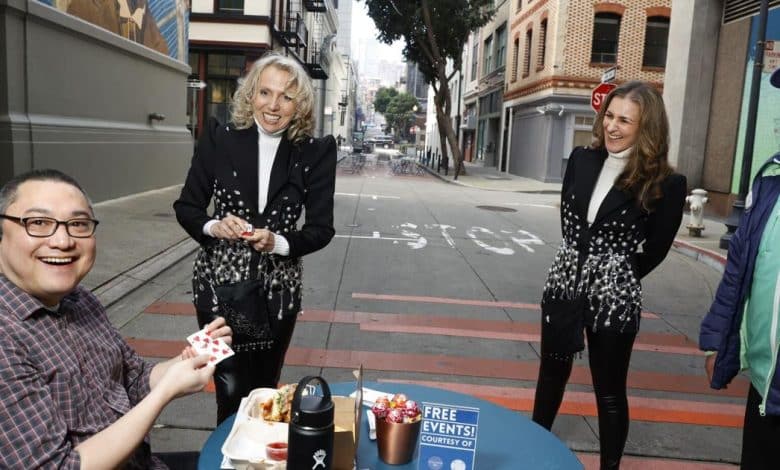
Mark Di Giorgio was out for lunch on Commercial Street, a historic alleyway in San Francisco’s Financial District, when two women in rhinestone-studded black outfits accosted him.
To Di Giorgio’s surprise, Heather Rogers and Velia Amarasingham were magicians who proceeded to amaze him with their tricks. He was left stupefied after Rogers put a spongy ball in his hand — but when he unclenched his fist, he was holding two balls.
“The magic is crazy,” said Di Giorgio, shaking his head. “This is one way to get people back to the office — and out of the office.”
Those are some of the main goals that the Downtown SF Partnership — an association of downtown property owners — was hoping to achieve by hiring Rogers, Amarasingham and other entertainers to perform at the corner of Leidesdorff and Commercial streets, an intersection that’s been closed to traffic since July 2023 in hopes it will become a bustling pedestrian hangout.
“What we’re trying to do is create new public spaces and activate them on a regular basis with art, entertainment, music, various programming, new seating, landscaping, some string lighting,” said Robbie Silver, executive director of Downtown SF Partnership, a community benefit district founded in 2020 that oversees 43 blocks across the Financial District and the Jackson Square Historic District. “We’re in the phase of throwing spaghetti on the wall and seeing what sticks.”
It’s an effort with some urgency given that downtown San Francisco finished 2023 with a 35.6% office vacancy rate, according to real-estate firm CBRE. For the week ending Jan. 24, an estimated 131,345 fewer workers on average were coming to San Francisco metro area offices than before the pandemic and the rise of remote work.
The crisis has shuttered suppliers, retail stores and restaurants. Downtown SF Partnership’s website alone recently listed 53 retail spaces available for rent.

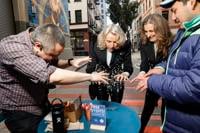
Magicians Heather Rogers (center left) and Velia Amarasingham (center right) levitate the glasses of Vincent Laurel (far left) from a table with help from Zuriel Ortegon (right) at Landing at Leidesdorff in downtown San Francisco.
Craig Lee/The Examiner
Silver, whose organization also cleans the sidewalks, is guided by a 143-page “public realm” action plan commissioned from SITELAB urban studio, an urban-design and strategy firm. He calls his group’s placemaking initiatives and events acts of “tactical urbanism” that ideally cost relatively little and don’t require shovels.
“We’re using the events and activations to try to change the narrative and perception around downtown,” said Silver, who nevertheless recognizes that there are big market forces governing downtown’s fate that he cannot affect.
Downtown SF Partnership’s first initiative involved painting a mural on a decommissioned stretch of pavement near Market Street known as Battery Bridge and placing furniture for people to use while listening to live music on Thursdays during the summer.
Another, which got some city funding, centers on games. Chess boards are set out every Thursday in a cleaned-up Mechanics Plaza, where experts from the neighboring Mechanics’ Institute, home of a historic chess club, give players pointers.
“We make destinations and create signature events that people want to come down for consistently,” Silver said. “So you’re rethinking the narrative about what downtown is, or what you expect to see.”
For Bastille on Belden, the group handed out 600 berets to the strains of accordion music at a party in honor of France’s national day on Belden Place, a hive of restaurants known for its quaint outdoor eating. Silver’s group also hired architects to help make the Belden streetscape more inviting, for example, by moving a forbidding gate and giving out small grants for restaurants to spruce up appearances.

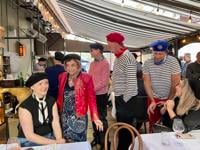
This year’s “Bastille on Belden” block party celebrates The City’s French roots while also jumpstarting downtown San Francisco’s future.
Courtesy of Downtown SF Partnership
The organization’s highest-profile project thus far has been Let’s Glow SF. Over 10 nights in December, the event drew an estimated 67,000 people downtown to see laser projections of artwork on the sides of buildings. Downtown SF Partnership, which got some funding from The City, estimated attendance for the third annual show from commercially available cell phone tracking data and put the economic impact at about $8 million.
John Bryant, CEO of the Building Owners and Managers Association of San Francisco, said his organization helped sponsor Let’s Glow SF to “create the opportunities to bring people downtown in a safe environment. And it really is making a difference.”
The notion of “activating” public spaces with attractions small and large for economic and social-development purposes has been embraced by business leaders and city and state officials and is being pursued by agencies and groups around The City.
A particularly dramatic example is the $2 million overhaul of UN Plaza unveiled by Mayor London Breed in November, which put a skateboard park and an exercise pavilion that professional trainers can use to hold classes in a spot notorious for rampant drug use.
Matthew Ziegler, a Zumba teacher who teaches classes for The City in nearby Civic Center Plaza, said he first thought a skateboard park was a “ridiculous” idea, but the boarders’ constant activity appears to have significantly driven the drug users away. The exercise structure also is getting used, he said.
“It’s a huge improvement,” he said. “It’s really pretty dramatic to me.”
Further downtown, The City sponsored last year’s Bhangra & Beats Night Market, a multi-night celebration of Punjabi music and dance that drew thousands to Battery and Clay streets, and a series of art and makers markets in the Yerba Buena Community Benefit District, among other events.

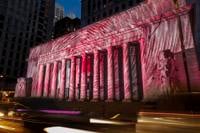
Let’s Glow SF light show on the Pacific Coast Stock Exchange at 301 Pine Street in San Francisco on Monday, Dec. 4, 2023.
Craig Lee/The Examiner
Still to come are details about a series of free concerts at Civic Center Plaza, Union Square and the Embarcadero that event promoter Another Planet Entertainment agreed to stage when it won approval for shows at the Polo Field in Golden Gate Park.
The Leidesdorff site, once marked by tent encampments and graffiti, is a more permanent project for which the Office of Economic and Workforce Development contributed $385,000, about a third of which is reserved for programming.
The site has been branded with the help of a consultant as the Landing at Leidesdorff, because The City’s shoreline ran there before settlers filled in the bay.
A huge mural was painted on two walls of a building on the southwest corner of the intersection, with a group of business interests covering the $100,000 cost. The colorful painting depicts elements of early California history and the figure of William Leidesdorff, a successful African American pioneer businessman.
Each day, some of Downtown SF Partnership’s 30 “ambassadors” put out tables and chairs for the public. Foot traffic is typically light, even at lunchtime. Sometimes, one or more people will be out reading or looking at a phone, but often, the chairs sit empty while a handful of people cluster at the tables outside several restaurants down the block. That’s where musicians hired by Downtown SF Partnership periodically perform.
Tristen Philippart de Foy, managing partner and director of operations for Heartwood restaurant, said it’s been challenging since he and his partners opened on Commercial Street in April because the Financial District has been a relative “ghost town.”
Downtown SF’s interventions, for the most part, have not yet produced the regular foot traffic Philippart de Foy said he hopes to see, though the “Let’s Glow SF” events were a major boost for business. Still, its initiatives have created a more beautiful environment and provided hope, and Philippart de Foy said he thinks they will draw more people out when spring and summer bring milder weather.
Completion of construction on improvements at the Redwood Park, just a block away at the Transamerica Tower, could also be a boon. Developer Michael Shvo said the park will be activated with musical performances and other events and could draw three million people annually.
“That’s going to help the whole downtown core,” Silver said.
Some programming offerings have fallen comparatively flat. The free yoga classes, for example, had no takers.
“It’s not a yoga environment,” said Denise Barnhart, Downtown SF Partnership’s new events and activations manager, gesturing toward the sound of construction crews in the distance. “It didn’t work.”
But the good thing about being a “small, scrappy nonprofit,” she said, is that Downtown SF Partnership can try new things, and if they don’t work, quickly change direction.
Rogers, the magician, found enough people to regale with her talents for the third of her three scheduled performances.
“We’ve been really enjoying this,” said Rogers, who often works corporate gigs with her partner. “It’s like guerilla theater.”
Vincent Laurel, the controller for Good Food Guys, the nearby owner of a chain of restaurants, saw the sign for Rogers and Amarasingham’s act and made a point of bringing lunch to see them.
“Downtown’s been pretty barren,” he said. “There’s so many nice things downtown, it’s sort of a shame there aren’t more people here.”
For February, the Landing at Leidesdorff schedule calls for performances by five musicians and a lunchtime comedy show. Also, in honor of Black History Month, there will be outdoor showings of “Black Panther” and “Black Panther: Wakanda Forever.” Showtimes are set for about 6 p.m., and the neighboring restaurants Heartwood and Wayfare Tavern will be selling special dinners for people to eat during the films, Barnhart said.
Further out, Silver is considering holding an art fair, a Juneteenth celebration, poetry slams and book readings.
Silver is also trying to raise money to do two more placemaking projects with SITELAB.
One new project would be near the cable-car stop at Drumm and Market Streets, where Silver wants to create “a gateway” for visitors to The City, including art, seating and signage. Barnhart said she’s eager to hire musicians and other performers to provide entertainment.
The second initiative would turn Front Street between California and Sacramento streets into a festive zone by regularly closing the road to traffic for music and festivals, an idea championed by Mayor Breed. The street is home to several historic bars, one of which is closed but was just purchased and is expected to reopen soon.
State Sen. Scott Wiener also said he sees potential for such gathering spots and recently introduced legislation, co-sponsored by The City, to let cities create outdoor entertainment zones where bars and restaurants can serve alcohol, something he said is done successfully in other states.
“Once people know, ‘Oh, this is an entertainment zone in downtown San Francisco, with some fun bars and cool restaurants,’ people will want to come downtown,” he said.
“Now’s the time to double down on programming and activation and public-realm improvements,” Silver said. “You don’t pull back when conditions are tough. We’re not stopping.”



